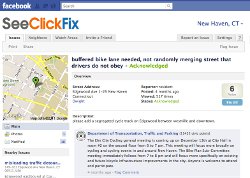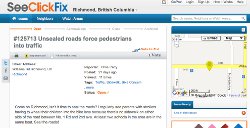SeeClickFix: A Tool for Neighborhood Empowerment
New Haven, Connecticut
Source: Pedestrian and Bicycle Information Center (PBIC)
Background
Ben Berkowitz, founder of SeeClickFix, was inspired after leaving several voicemail messages and waiting in line at City Hall to deal with a chronic graffiti problem on his street - why had it taken so long to get the issue resolved? With friends based in New Haven, Connecticut, he built a web and mobile-based solution that launched in March of 2008 (1).
Problem
Every city develops spot-specific issues with public infrastructure and/or operations of public services. Traditionally, these issues have been reported by city employees themselves or by a few very concerned citizens. Many citizens remain uninvolved in local service issues; those who have are often frustrated with how their complaints are managed or the lack of response by officials. A cheaper and more efficient non-emergency problem management system is needed in order to encourage more citizen participation, more transparent city response, and better public spaces and services. For bicyclists and pedestrians, unresolved issues such as potholes, graffiti, and obstructed rights-of-way are deterrents to bicycling and walking that need to be addressed.
Solution
SeeClickFix provides the web and mobile technology to crowdsource (i.e., outsource the task of issue reporting to large groups of people or communities, "crowds") the reporting of these issues, send alerts directly to the responsible party in city government, and provide transparency to the citizen and the community at large on whether or not an issue has been simply acknowledged or fully solved. When a user logs an issue on the SeeClickFix website, through the mobile app, or through the Facebook application, it is viewable to the public as "open," "acknowledged," or "closed" - providing a layer of accountability for local governments. Issues remaining "open" or "acknowledged" for too long may reflect poorly on city management and a neighborhood's elected officials.

Image Source: Emma Richards
While not explicitly related to bicycle and pedestrian infrastructure, many of the citizen reports concern sidewalks and streets. All historical data collected by the site are available online and can be downloaded in a number of formats (e.g. Excel); cities that subscribed to the service receive monthly reports of all outstanding issues. This information is meant to empower local neighborhood groups and advocates who can identify trends (for example, a particular bike lane is chronically blocked by trash receptacles), inform local governments and police forces on where attention is needed, and provide media outlets with current information about where stories are happening or where chronic issues exist. This last function provides an additional layer of accountability when media outlets pick up on issues that have remained unsolved for extended periods of time.
Results
Each city utilizes the SeeClickFix tool slightly differently. In some municipalities, citizens have taken it upon themselves to create "watch areas," for which the citizen inputs the public email address of the area's elected official, Mayor, or other responsible party. After this email address has been designated, all issues are directed to that person automatically. Paying clients use the SeeClickFix PLUS or CONNECT products, which integrate into a city's existing non-emergency response system.
The free version of SeeClickFix is often used by citizens, neighborhood or advocacy groups, or media outlets. Citizens can create a watch area around their neighborhood, sending email alerts directly to their city counselor or supervisor; advocacy groups can manage the incoming issues themselves and use that information to push for targeted improvements; and media outlets can use SeeClickFix as a user engagement tool by developing public stories related to a particular issue.

Image Source: Emma Richards
The Atlanta Bicycle Coalition provides a good example of an advocacy group's use of the tool. Their website (2) provides a portal for collecting issue reports. The community is extremely active; in the month of September 2011, 100 issues were opened, 5 closed, and 6 acknowledged. The coalition manages the incoming reports and uses their connections to the city to resolve issues pertaining to bicyclists. This use of SeeClickFix is free to the bicycle coalition.
WBTV in Charlotte, North Carolina provides another example. As a media outlet, WBTV both actively collects issues from the public on their website and creates news segments highlighting some of those reports. The news reports draw attention to their program and provide accountability for the city. Several segments per week are featured on WBTV. A recent segment focused on the need for a mid-block signalized crosswalk near a public school (3).
Instead of relying on advocates and media partners to manage and prioritize issues, some cities become paying customers of SeeClickFix. A PLUS client designates particular email contacts for particular issue types (for example, a pothole would be automatically reported to the department of public works, while graffiti might go to a code enforcement officer). These clients have access to a dashboard - a sort of control panel for reported issues - which enables a manager to route an issue to the appropriate party in city government. Raleigh, North Carolina and Richmond, Virginia are PLUS clients, and both have a reputation for responding to SeeClickFix requests quickly (4). Richmond holds itself accountable by providing status transparency on all reported issues; their Mayor's Participation, Action & Communication Team website displays a counter of reported, open, acknowledged, and fixed issues (5).
CONNECT customers are often large cities with established 311 services - a phone line and database for collecting and managing issues, much like SeeClickFix itself. In these cities, SeeClickFix can be integrated into the existing system, sending reports directly to the relevant party.
Cost
Use of the website and downloadable data are free. Citizens, advocacy groups, and media outlets typically use the free version. Cities who integrate the PLUS version are charged $100/month/100,000 citizens. Integrating the CONNECT product is more customized and therefore, the fee is tailored to each city's situation (6).
Limitations
The major limitation of the service is its limited ability to provide accountability - will SeeClickFix actually get things done? According to an interview with Ben Berkowitz, roughly 40% of issues on the site are resolved (7). Still, many issues go unresolved or remain open for a long time. SeeClickFix responded to this criticism in a recent blog post, citing their promotion of the top performing cities as a way to hold others accountable (8).
As a web and mobile platform, SeeClickFix runs the risk of highlighting issues that are clustered around higher-income neighborhoods that, compared to lower-income areas, traditionally have disproportionately higher access to high-speed internet and a greater proportion of residents with the resources to utilize the site. While infrastructure improvements can benefit all citizens in some way, this limitation highlights the need for planners and agency staff to provide alternatives for citizen engagement and to proactively address concerns in low-income neighborhoods, where residents may lack the resources to organize themselves around community concerns.
Other Potential Uses
Because issue report data is open to the public, it could be easily used by public or private bicycle and pedestrian planners or advocates. For planning, it can aid in existing conditions research and for identifying areas of chronic concern but should not be the only source of this information. PLUS and CONNECT cities could route bicycle and pedestrian issues directly to these planners; citizens could be encouraged to do the same for non-client cities. For advocacy, it can point groups to neighborhoods where outreach may be most needed and inform improvement campaigns.
The city of LeDuc used SeeClickFix to collect citizen input into their Transportation Master Plan (9).
A Brooklyn, New York neighborhood used SeeClickFix to call the city's attention to the need for more bicycle racks (10).
Further Information
Emma Richards, Community Manager, SeeClickFix, emma@seeclickfix.com
Doug Hardy, Columnist, Journal Inquirer, http://www.journalinquirer.com
Contact
Terra Curtis
Graduate student, Department of City and Regional Planning, University of North Carolina at Chapel Hill
tmcurtis@email.unc.edu
Notice
The Pedestrian and Bicycle Information Center, funded by the US Department of Transportation's Federal Highway Administration, does not endorse specific products or manufacturers. Trade and manufacturers' names appear in this case study only because they are considered essential to the object of the document. An attempt was made by the author to ensure that all information was balanced and factual at the time preceding publication. If you have additional information or suggestions for case study content, please contact PBIC at pbic@pedbikeinfo.org.
References
1. Fenton, D. (2010, Dec 2). HuffPost's greatest person of the day: Ben Berkowitz, co-founder of SeeClickFix. Huffington Post. Retrieved from http://www.huffingtonpost.com/2010/12/01/huffposts-greatest-person_15_n_790588.html.
2. Atlanta Bicycle Coalition. (2009). See-Click-Fix: Report a bike hazard and watch it get fixed! Retrieved from http://www.atlantabike.org/SeeClickFix.
3. Nelson, C. (2011, Aug 2011). See, Click, Fix: Parents say intersection "dangerous." Charlotte: WBTV. Retrieved from http://www.wbtv.com/story/15369120/see-click-fix-parents-say-intersection-dangerous-for-students.
4. E. Richards, personal communication, September 29, 2011.
5. City of Richmond. (2011). Mayor's participation, action & communication team. Retrieved from http://www.richmondgov.com/content/MayorsParticipationActionCommunicationTeam/index.aspx.
6. Emma Richards, personal communication, September 29, 2011; SeeClickFix. (2010). Contact us for invoice billing. Retrieved from http://www.seeclickfix.com/pricing.
7. Blip TV. (2010, Sep 15-16). BIF-6: Ben Berkowitz. Retrieved from http://blip.tv/file/4231718.
8. E. Richards. (2011, Jul 5). Accountability for all. Retrieved from http://seeclickfix.blogspot.com/2011/07/accountability-for-all.html.
9. M. Dalton. (2011, Sep 2). City of LeDuc develops 'transportation master plan.' Retrieved from http://seeclickfix.blogspot.com/2011/09/city-of-leduc-develops-transportation.html.
10. G. Kral. (2011, Jun 30). Columbia St. requested bike racks - and got 35. Retrieved from http://carrollgardens.patch.com/articles/columbia-street-requested-bike-racks-and-got-35.
Image Sources
Emma Richards, SeeClickFix




